Imagine yourself, camera in hand, walking through a busy metropolis. The sights, the sounds, and the smells of a bustling city overwhelm your senses. People all around you are scurrying to and from work. Others are sitting in outdoor cafes enjoying lunch. You can see worn out shoppers, their hands filled with packages, moving from store to store. The city is alive with activity.
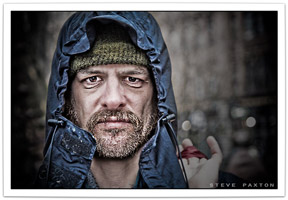 As you survey the scene, you spot an elderly man across the street sitting alone in a wheelchair. He holds a small cup out and thoughtfully watches the activity. You’re amazed at how seemingly invisible he is. No one gives him a second glance. In fact people seem to be going out of their way to avoid him. As you look further you notice that this poor man has no legs and is missing part of his left hand. You can also see that he has been wearing the same clothes for quite some time.
As you survey the scene, you spot an elderly man across the street sitting alone in a wheelchair. He holds a small cup out and thoughtfully watches the activity. You’re amazed at how seemingly invisible he is. No one gives him a second glance. In fact people seem to be going out of their way to avoid him. As you look further you notice that this poor man has no legs and is missing part of his left hand. You can also see that he has been wearing the same clothes for quite some time.
Have you ever considered approaching someone like this for an urban portrait? If not, why not?
It’s easy to fall into a rut of photographing the same kind of stuff day in and day out. If you’re a landscape or wildlife photographer, you may get up early for the sunrise and hike out to beautiful locations. Wedding photographers are all business on a bride’s big day making sure to capture all the memorable moments. Sports photographers create compositions that help tell the story of how a game was won or lost. It’s easy to get locked into one or two specific subsets of photography (especially if you’re a professional photographer). Most of us began with a simple passion for photography. When I seriously started taking pictures (using an old hand-me-down Canon SLR), I photographed everything in sight! My girlfriend at the time (now my wife) had to put up with me stopping every couple of minutes to take photographs. I know it drove her nuts (although she would never say so). I had no idea what I was doing, but I was passionate so I shot everything I laid my eyes on.
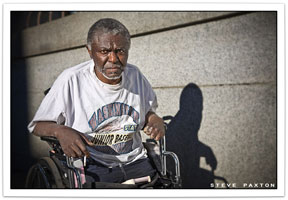
Remember Your Safety
We can’t have a discussion about approaching strangers in a city environment without first talking a bit about safety. Safety is an important part of taking urban portraits so please stick with me. Approaching strangers for portraits can come with a bit of risk, especially if you decide to photograph individuals living on the streets. Lugging expensive camera gear around in not-so-great parts of town paints a target on your back for robbery. People who are high or intoxicated and those with mental health issues can react unpredictably. There isn’t a photograph in the world worth getting hurt over.
Keep in mind that crooks are typically looking for easy targets—people not paying attention to their environment. The best thing you can do to reduce the risk of getting hurt is to take someone with you. Your field of view narrows as you begin engaging people for urban portraits. It’s very easy to lose track of what’s happening around you. It is impossible to look through the viewfinder and pay attention to your environment. A second person can step back, watch the overall scene and ensure that nobody surprises you from behind. If things start going sideways during a contact on the street, your partner can call the police, run for help, or make noise to draw attention to what’s happening. Your partner can also help watch your equipment.
 More on Safety
More on Safety
Avoid venturing into extremely isolated areas and consider taking a cellphone with you so that you can quickly call for help. It’s also a great idea to bring a whistle along so that you can easily draw attention to yourself if necessary.
Body language speaks volumes. More than 80 percent of communication is non-verbal. I always try to pay attention to what people are saying with their body language. People with their head down or who refuse to look at you generally don’t want to be approached. Respect that and move on. I usually avoid contacting people with extreme mental health issues (e.g., talking to self, screaming at the air, etc.) and heavily intoxicated individuals. A good rule of thumb is to remember that intoxication = unpredictability. I am not suggesting that you never approach someone who has had a bit to drink; just be cautious of approaching people who are extremely blotto.
I ignored this rule one day when I noticed a man sitting alone in the middle of a secluded alley (see the images below and above). He was just finishing a 40-ounce beer and was clearly intoxicated. Ignoring the red flags, I walked down the alley and contacted him. Within a few moments of conversation, he suddenly stood up and came within a short distance of my face. First he demanded to know if I was a cop and then asked for money. Next he reached out and firmly grabbed my right arm. I was totally alone in the alley with this guy. At one point I actually wondered if he was going to hit me with the nearly empty beer bottle he was still holding. I was able to calm him down and avoided getting hurt; however, this situation could have turned very ugly. This guy was obviously very intoxicated. He was situated in a very secluded alley (where help was not readily available) and I was working alone. I should have never approached him under these circumstances.
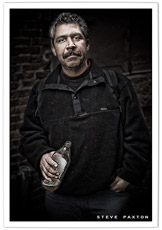
- Take a partner. Remember there is safety in numbers.
- Consider taking a cellular phone so that you call for help.
- Consider taking a whistle so that you can draw attention to yourself if necessary.
- Avoid going into extremely isolated areas.
- Avoid contacting extremely intoxicated subjects and those with extreme mental health problems.
- Pay attention to body language. Don’t approach people who have their head down and those who seem to be going out of their way to avoid making eye contact with you.
- Be careful not to invade personal space during your contacts. A good rule of thumb is to stay three to five feet away from people.
- Stand bladed at 45 degrees with your feet planted shoulder width apart and your knees slightly bent. This should help keep you balanced on your feet and afford you some stability if you need to react quickly or escape.
- Make brief eye contact with the people around you (but don’t stare). Let people know that you see them.
- Be aware of your surroundings.
- Listen to your intuition and move out of the area if you start feeling uncomfortable.
Street Portrait Equipment
I travel very light while working in an urban environment. I usually only bring a single DSLR and lens. Currently I am shooting most of my urban portraits with a Canon 5D and a 24–105mm lens. I pack it in a Lowe Pro shoulder bag (slung crossways around my body). Traveling light allows for quick access to my gear and makes it a snap to walk many city blocks without tiring out. Occasionally I bring a monopod if the weather is dark and gloomy (e.g., cloudy winter weather). I like to shoot tightly cropped portraits. A medium length zoom lens comes in handy for capturing close up portraits without getting right in the person’s face. Another benefit of traveling light is that it won’t be necessary to put your gear down while you shoot.
Generally I avoid using a flash while shooting urban portraits. This is contrary to the traditional rule of thumb of using fill flash for environmental portraits. In an urban environment a flash is usually very distracting to the person you are trying to photograph and it is possible to get high quality results using natural light. I will discuss lighting in more detail further along.
 Attire
Attire
Does your clothing matter? You bet it does. Blending into your environment is crucial. On more than one occasion I have had a street person comment on my jacket: “Is that a North Face? That sure looks nice.” It makes sense to do whatever you can to reduce class differences if you’re planning to photograph the homeless and less fortunate. Walking up to a homeless person dressed in expensive clothing only serves to remind that person that they are poor. Questions and comments about your clothing make it much more difficult to establish the initial rapport that is so important. Consider dressing down a bit before going out. Instead of wearing an expensive leather coat, throw on an old work jacket. Ditch the $200 sneakers and wear old shoes. I am not suggesting that you wear uncomfortable clothes, just pay attention to what you put on.
Shutter, Aperture, and ISO
The first thing I do before I start pounding the pavement is to set my camera to Aperture Priority mode and adjust my exposure for the available light. I generally choose a wide aperture such as f/4 or f/5.6 and try to keep my shutter speed at 1/125 of a second or higher. Having a slightly faster shutter speed helps reduce camera shake (since I shoot most of my images hand held) and it helps freeze the portrait. I have found that almost all of my “urban clients” look around nervously while I’m shooting. If your shutter speed slips down to 1/80 or lower, you may find that a lot of your images are blurred from the movement (especially if you’re using a longer focal length). Pay close attention to the lighting as it can change dramatically depending on whether you are in an alley or a more open street environment. Using a lens with a built in stabilizer or anti-shake option is a plus.
The key to getting the right aperture/shutter speed combination is setting the ISO appropriately. Don’t be afraid to raise your camera’s ISO to 800 or higher. A bit of digital noise usually enhances the overall feel of street portraits anyway. It is much better to have to deal with some digital noise than to have a series of great shots completely ruined because they are blurred (as a result of using a slow shutter speed). On more than one occasion I have deliberately under exposed a string of images by a stop or two when the ambient light has been low. This buys me extra shutter speed. Since I shoot everything in RAW format, it’s a cinch to regain the exposure later on in Photoshop or Lightroom.
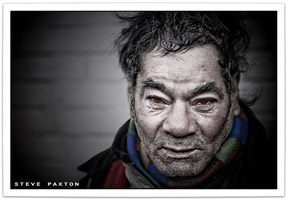
Where to Start
I’ve captured many of my urban portraits within a five-block radius of downtown shelters. I also have a lot of luck making contacts with panhandlers in dense shopping districts. Panhandlers take up positions in areas where heavy pedestrian traffic passes by. Every city is unique. Jump on the Internet and discover where the shelters, food banks, and city services are located. This should help get you pointed in the right direction.
The Approach
There are some that advocate taking urban photographs of people from a distance or shooting off the hip in an attempt to conceal the fact that you’re taking a picture of them. Some even suggest that you should just walk up to people and take the photographs you want without asking (paparazzi style). I think this extremely rude—not to mention dangerous. Admittedly there are times when a unique situation involving strangers unfolds and it makes sense to photograph it. These situations are usually observed from a distance and qualify more as a kind of photojournalism than portrait photography. For urban portrait work, I almost always get permission first.
Connecting with the person you’re photographing usually translates into much better images anyway. I try to create micro-relationships with each individual I photograph (just like you would with a regular portrait client). I want to put the person at ease and capture their portrait when they are feeling the most comfortable with me taking the photographs. This is not always easy to do; however when you’re successful connecting with the person, you end up with much better shots.
I have found there are two main ways to make contact with people on the street. The easiest kind of contact is one where the individual approaches you. The second type of contact is a cold approach where you identify an individual and make contact with them. This is the hardest kind of contact and requires a bit of work. I regularly use both strategies. I will start by explaining the first approach.
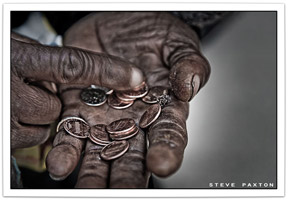
The simplest way to start taking urban portraits is to deliberately position yourself in places where you will be solicited by panhandlers. This is a great way to get started if you are afraid of making cold contacts with people. I can walk through several blocks of a shopping district in Seattle and get solicited for spare change multiple times. Instead of ignoring these folks, look at it as an opening.
Here is how a typical exchange might go:
Panhandler: “Can you spare some change?”
You: “Sure… (drop some change in the cup) What’s your name?”
Panhandler: “Todd”
You: “Todd, I am Steve.” “Are you from Seattle, Todd?”
Panhandler: “I am originally from Chicago…”
You: “Oh really, what part?”
Obviously there are quite a few different ways a conversation like this can unfold. If you’re successful, within a few minutes you will have created a rapport with the panhandler. The key to starting a conversation is having an opener. As the conversation moves along it is not too uncommon for the panhandler to ask where you are from and what you are doing. This is a great opener for telling them you’re a photographer, which then leads to asking to take their photograph. Oftentimes I carry my camera in hand so that they can easily see that I am a photographer. On more than one occasion I have had panhandlers ask if I was a photographer.
Read this next paragraph carefully if you want to be successful taking urban portraits.
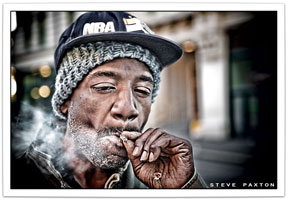
Once you feel comfortable and have established a rapport then it’s appropriate to ask if you can take a few photographs. Sometimes I mention that I’m a portrait photographer and offer them my business card. If they ask why I want to take their photograph, I simply explain that I enjoy taking pictures of the people I meet. Depending on the situation I might ask if they have an email address and offer to send them a few images (many homeless folks have an email address that they can check at the local library).
The Cold Contact
The second approach involves making cold contacts with people on the street. This kind of contact requires more creativity. You may decide to make a cold contact when you see someone who catches your eye for some reason. This could be an elderly person in a wheel chair, a man with an extremely wrinkled face sitting on a curb or a woman sitting alone on a park bench.
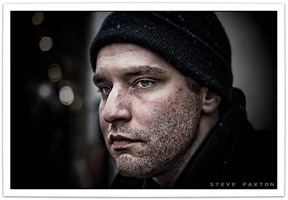
You: “Hello…do you know where Washington Avenue is?”
Street Person: “Hmmm…I think it’s two blocks that way.”
You: “Thanks (looking around). Are you from around here?”
Street Person: “Why?”
You: “Oh…I am just a little turned around.”
Street Person: “I am originally from Chicago”
You: “Have you been living in Seattle long?”
Despite it being deceptive on my part to ask for directions, I have found this is the best kind of opener for a cold contact. If you have a problem with this approach, the alternative is to simply walk up and introduce yourself. This approach tends to be much less successful. People are usually very suspicious of the, “Hi, where are you from…” or “Hi, I am Steve Paxton, what’s your name…” question that seemingly comes out of nowhere. You have to ease into it. I recommend trying out a couple of different openers to see what works best for you.
Composition and Lighting
I have talked about the two main ways I make contact with people on the street. You have to tailor your approaches so that they work for you (and that you are comfortable with). Once you get permission to take the portrait, it’s time to break out the camera and start taking photographs. Your time is going to be very limited (several minutes at the most). As I am talking to the subject, I slowly sidestep in a circle until the best light is landing on my client. As you move and talk, the person will naturally track you with their head and body. This puts you in complete control of the lighting and background. Tall buildings act as natural reflectors and often create wonderful fill lighting. Move around as you talk until you find the most ideal lighting.
Along with lighting I also pay close attention to the background. For example, I try to minimize horizontal lines cutting through the person’s head and neck and other distracting elements. If the background is just too busy or distracting, bend down and shoot your portrait upward at a 45-degree angle. Remember to keep talking!
 Keep Talking
Keep Talking
I’m always asking questions as I shoot my photographs. This helps the client relax and forget that I am photographing them. I usually ask questions like how long they have been in the city, where they grew up and how they ended up living on the streets. I take a lot of photographs. I may take 50+ shots of a single person I contact in just a few minutes. I do this because I am capturing tiny little moments of that person’s life as they answer my questions. I am trying to capture the micro expressions that surface a fraction of a second at a time. These micro expressions are what separate mediocre urban portraits from good ones. Taking a lot of photographs is also an insurance policy against the blink factor (capturing shots of the person blinking) and blurred shots from movement.
If they seem interested, I may show them a couple of the images (by letting them see the LCD on the back of my camera). This can break the ice even further and allow you to shoot longer. Most people will only put up with a few minutes of you pointing a camera in their face. Don’t forget to move around and shoot from different vantage points. I always shoot tightly cropped photographs; however, I may back up and shoot a wider view especially when there are objects nearby that help tell the story.
Money
Sometimes I hand out a dollar or two near the end of a contact. Sometimes I don’t offer money and simply thank the client and move on. Every person is different. I really don’t like turning my urban contacts into a quid pro quo situation where I am paying a homeless person to photograph them.
You certainly need to take some money with you. I usually take ten dollar bills and a handful of quarters. I keep the bulk of the money in my right pocket and a single dollar bill and few quarters in my left pocket. Since I shoot with my right hand, I can quickly reach in my left pocket and scoop out a dollar bill and a few quarters. Separating the money keeps me from pulling out too many bills at once and making it appear as if I have a lot of money on me. I almost always say, “This is all I’ve got…” as I hand them the dollar out of my left pocket. The money part of this goes right to the heart of safety. It’s not a smart idea to advertise that you’re carrying gobs of money with you. I am very low key about giving away money and try not to make it a big deal. You might be surprised how many people who will allow you to photograph them without asking for money.
 Tell the Story
Tell the Story
I like to be able to document a little bit about each person I photograph on the street. Being able to tell a little bit of their life story makes your images stronger and more interesting. It also helps your viewers connect with the person on a deeper level. All the questions you have been asking during the build up and while taking the photographs is the story. Don’t let the information go in one ear and out the other. Remember their name and some of the basic details about their life. I have a terrible memory so I try to write out some basic notes immediately after each contact. It is not a bad idea to have a pen and small notepad in your camera bag (however don’t take notes during the contact).
Processing Your Images
Capturing urban portraits is only half the fun! Once you have captured a few shots, the next step is process the images. This is where individual style and taste really come into play. I like to desaturate my urban images and give them a gritty feel. There are lots of ways to achieve the look you are after. I encourage to you play around and experiment.
During processing you can also fine tune the lighting through basic dodging and burning. My typical workflow includes lightening the eyes, lightening shadows on the face, desaturating the color and significantly darkening the background (to make the portrait stand out a bit).
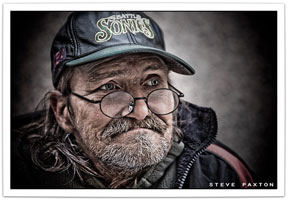
About the “Least of These” Series
The “Least of These” series is an urban portrait project with the central theme based on Matthew 25:34-40. Each image uniquely captures a person who is homeless, destitute or precariously in need. My goal has always been to capture the best in each person I photograph. This series has been no exception.
Matthew 25:34-40
34 “Then the King will say to those on his right, ‘Come, you who are blessed by my Father; take your inheritance, the kingdom prepared for you since the creation of the world. 35 For I was hungry and you gave me something to eat, I was thirsty and you gave me something to drink, I was a stranger and you invited me in, 36 I needed clothes and you clothed me, I was sick and you looked after me, I was in prison and you came to visit me.’
37 “Then the righteous will answer him, ‘Lord, when did we see you hungry and feed you, or thirsty and give you something to drink? 38 When did we see you a stranger and invite you in, or needing clothes and clothe you? 39 When did we see you sick or in prison and go to visit you?’
40 “The King will reply, ‘I tell you the truth, whatever you did for one of the least of these brothers of mine, you did for me.’
About the Author:
Steve Paxton currently lives with his wife and two children in the Seattle area. Steve has been a photographer for over ten years and has spent most of that time shooting with a variety of Canon 35mm cameras. His experience ranges from wedding and portrait work to crime scene photography; although he particularly enjoys the solitude of shooting landscapes.
Like This Article?
Don't Miss The Next One!
Join over 100,000 photographers of all experience levels who receive our free photography tips and articles to stay current:
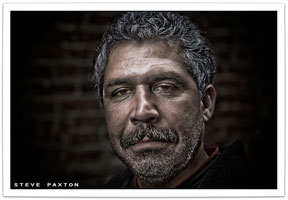 More on Safety
More on Safety Attire
Attire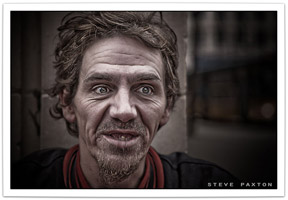 Keep Talking
Keep Talking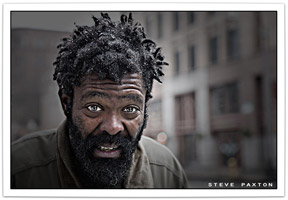 Tell the Story
Tell the Story





This is a fantastic guide for anyone interested in capturing stunning urban portraits! The variety of tips, from location scouting and composition to posing and lighting, is incredibly helpful. I especially appreciate the reminder to consider the urban environment as a character in itself. Thanks for sharing this informative resource!
Nice blog! I read this blog carefully and learned many of this from this blog. I think the photoshop beginner can learn a lot of things here. I really appreciate this blog. Thanks for sharing a nice idea.
Lovely article! The author owns the technique of street photography. I want to make the translation of the article into Russian and place it on my website. Of course I will make a link to your site. Will you give me such permission?
This is probably the most thought out article I’ve read on a photography “Tips” site. Thanks to the author for his compassion for others and sharing his techniques for putting people at ease.
Lord knows we need more compassion in this world.
Great article .this will definitely help to improve my skill. so thanks a lot.
Thanks for your urban portrait tips. Really nice. I really appreciate your work. Thanks again.
Awesome learning things about urban representation photography. The way you work with them was extremely awesome to take after. You are extremely experienced and this article will come to help for picture takers doing such sorts of work.
I would never imagine taking a photo of a homeless person and not give them some money or food in return. Especially if I intend to make money off a photograph of them. Be kind and give.
Great learning things about urban portrait photography. The way you work with them was really great to follow. You are really experienced and this article will come to help for photographers doing such kinds of work.
Thanks for a great article. The dialogue excerpts are particularly useful. You give a flavour of the topics and tone to use – which is something I struggle with. I’d be much more comfortable taking a photo after a brief chat than just snapping and walking on.
I’ve actually heard of The Least of These sometime before, thanks for giving out some great tips.
I’ve never really gotten into portrait photography much, and that may very well be because of my own un-comfort photographing people. Hopefully I can utilize your thoughts and suggestions in the future….
This is one of the best blogs on photography I have ever read. Thanks so much for sharing your knowledge and insight.
Steve,
This type of Street Photography requires a high degree of caution. People that you may wish to talk to or photograph may poise a security risk to an outsider because of their situation.
Tom
Great article Steve! Do you mind if I link it back to here for our website, http://www.slrlounge.com?
Also, which image can I use for it? I just need something that is 650px.
Thanks!
Best,
Joe Gunawan
SLR Lounge Editor
This is an awesome article accompanied by some fabulous photos. I have been wanting to try Street photography for some time and I’ve only had the nerve to do it once. I look forward to trying some of your techniques to approach people and handle the situation. Btw, I also love the fact that your photos are not the typical cliche B&W photos.
Thanks,
Scott
Mr. Paxton,
This is a wonderful piece that I stumbled upon this evening. I do have two questions though.
1 – If you want to publish these photo’s do you ask them to sign a model release?
2 – (Aside from personal pleasure) What would be a potential market for this type of photography?
Thanks much…..Love your work!
– JoAnn –
York, PA